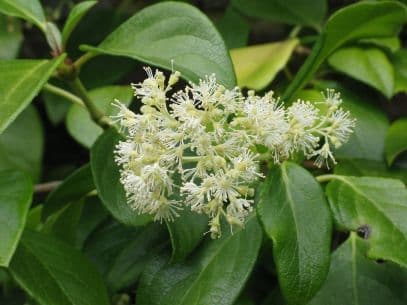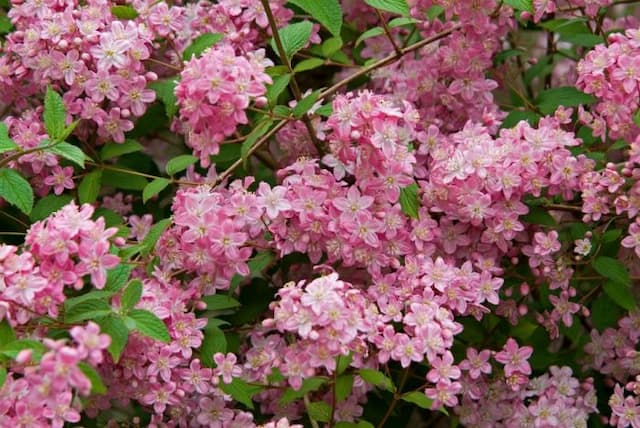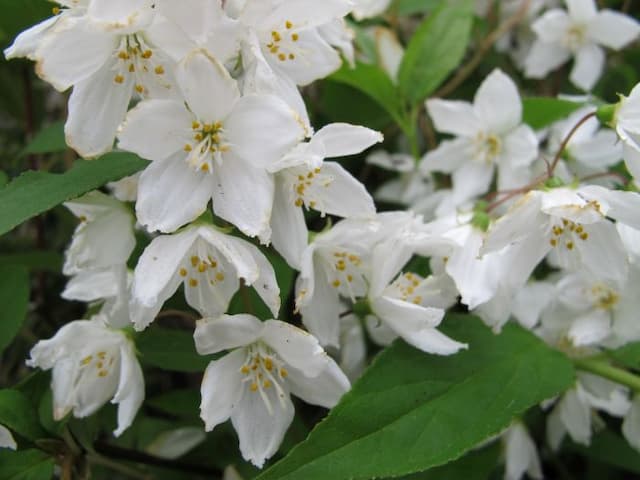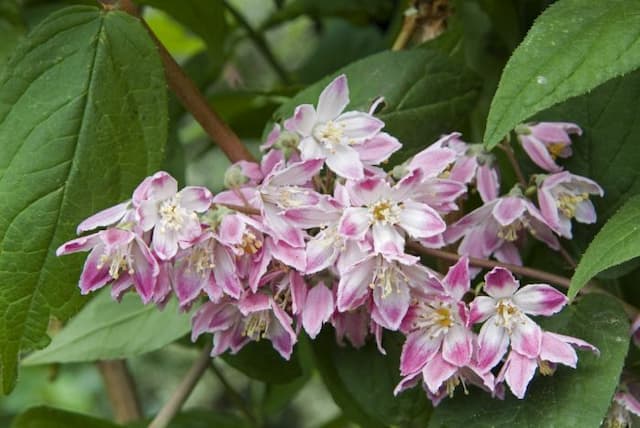Preziosa Hydrangea Hydrangea 'Preziosa'

ABOUT
Hydrangea 'Preziosa' is a captivating plant well-known for its showy and changeable blooms. The flowers emerge a delicate pink shade and as the season progresses, they undergo a stunning transformation through various hues, eventually turning a deep, rosy burgundy. These blooms cluster together in large, rounded mophead inflorescences, which create a lush, eye-catching display. The leaves of the Hydrangea 'Preziosa' contribute to its beauty as much as the enchanting flowers. Initially, the foliage presents a fresh, vibrant green color. With time, as the seasons change, the leaves take on tinges of red and purple, complementing the evolving flower colors and adding another layer of visual interest to the shrub. Beyond its charming flowers and foliage, this plant's branches and stems also add to its overall appeal. The sturdy stems hold the heavy flower heads aloft, giving the plant a robust and alluring presence in any garden or landscape. Hydrangea 'Preziosa' is appreciated not only for its delightful aesthetic but also for its adaptability to a variety of garden settings, making it a versatile choice for gardeners looking to add a touch of romance and color transformation to their outdoor spaces.
About this plant
 Names
NamesFamily
Hydrangeaceae.
Synonyms
Preziosa Hydrangea, Preziosa Serrated Hydrangea.
Common names
Hydrangea macrophylla 'Preziosa'.
 Toxicity
ToxicityTo humans
Hydrangeas, including the 'Preziosa' variety, contain compounds called cyanogenic glycosides, which can release cyanide when chewed or digested. If ingested in large quantities, these compounds can lead to toxicity in humans. Symptoms may include stomach upset, vomiting, nausea, and diarrhea. In severe cases, cyanide poisoning can cause dizziness, increased heart rate, and convulsions. It is rare for these symptoms to progress to life-threatening conditions, but it's important to seek medical attention if hydrangea ingestion is suspected.
To pets
Hydrangeas, including the 'Preziosa,' are also toxic to pets, including dogs, cats, and horses. These plants contain cyanogenic glycosides, which can release cyanide into the body when the plant is ingested. Symptoms of poisoning in pets may include gastrointestinal upset such as vomiting and diarrhea, lethargy, depression, and confusion. In severe cases, ingesting hydrangea can lead to increased heart rate and seizures. It is important for pet owners to contact a veterinarian promptly if their animal ingests parts of a hydrangea plant.
 Characteristics
CharacteristicsLife cycle
Perennials
Foliage type
Deciduous
Color of leaves
Varies
Flower color
Varies
Height
4 feet (1.2 meters)
Spread
4 feet (1.2 meters)
Plant type
Shrub
Hardiness zones
6
Native area
Japan
Benefits
 General Benefits
General Benefits- Aesthetic Appeal: Hydrangea 'Preziosa' offers large, showy blooms that can range in color from pink to purple, depending on soil pH.
- Landscape Versatility: This plant can be used in a variety of landscape designs, including borders, as a focal point, or in mass plantings.
- Seasonal Interest: It provides visual interest across multiple seasons with flowers in the summer and attractive foliage and seed heads in the fall.
- Attracts Pollinators: The flowers attract bees and butterflies, supporting pollinator populations.
- Low Maintenance: It requires minimal care once established, just needing adequate moisture and occasional pruning.
- Durability: Hydrangea 'Preziosa' is relatively hardy and can withstand different environmental conditions.
- Easy Propagation: It can easily be propagated from cuttings, making it simple for gardeners to create more plants.
- Shade Tolerance: While it thrives in full sun to partial shade, it is one of the few flowering plants that can bloom even in shadier spots.
 Medical Properties
Medical Properties- This plant is not used for medical purposes.
 Air-purifying Qualities
Air-purifying QualitiesThis plant is not specifically known for air purifying qualities.
 Other Uses
Other Uses- Hydrangea 'Preziosa' can be used as a natural pH indicator in science experiments due to the fact that the color of its blooms can change based on the soil acidity.
- The flowers of the Hydrangea 'Preziosa' can be dried and used in potpourri to provide a pleasant fragrance to rooms and closets.
- The sturdy wood of the Hydrangea 'Preziosa' makes it suitable for creating very small wooden crafts or jewelry.
- With their large and colorful blooms, Hydrangeas can be used in natural dyeing processes for fabrics and yarns.
- Dried Hydrangea 'Preziosa' flowers can be used in making decorative bookmarks, encapsulated in transparent papers or laminates.
- The Hydrangea 'Preziosa' leaves can be used in educational settings to help students learn about leaf anatomy and morphology.
- During festive seasons, the branches and flowers of Hydrangea 'Preziosa' can be used to create unique, natural Christmas ornaments.
- Hydrangea 'Preziosa' can add aesthetic appeal to themed events or weddings when used as part of table centerpieces or garlands.
- The plant can be included in a butterfly garden, as Hydrangeas are known to attract butterflies and other pollinators.
- Photographers can use Hydrangea 'Preziosa' as an attractive background or focus for nature photography due to their lush and vibrant blooms.
Interesting Facts
 Feng Shui
Feng ShuiThe Hydrangea is not used in Feng Shui practice.
 Zodiac Sign Compitability
Zodiac Sign CompitabilityThe Hydrangea is not used in astrology practice.
 Plant Symbolism
Plant Symbolism- Heartfelt Emotions: Hydrangeas often symbolize deep feeling and heartfelt emotions due to their lush and abundant flower heads.
- Gratitude: The hydrangea can be a symbol of thankfulness, often given as a gift to express gratitude.
- Understanding: In some contexts, hydrangeas can denote an understanding between people, as their diverse flower colors suggest versatility and depth of perception.
- Apology or Forgiveness: The ability of hydrangeas to absorb and transform soil nutrients into different flower colors symbolizes the capacity for change, making them suitable for apologies or seeking forgiveness.
- Boastfulness or Vanity: In some cultures, hydrangeas symbolize boastfulness or vanity, reflecting the showiness of its large blooms.
- Frigidity or Disinterest: The hydrangea's origins in Japan gave rise to a meaning of dispassion or frigidity, particularly in romantic contexts, potentially due to its less fragrant flowers.
- Abundance and Prosperity: Because of their full and vibrant blooms, hydrangeas can be associated with abundance and prosperity.
- Fourth Wedding Anniversary: Hydrangeas are often recognized as the traditional flower gift for the fourth wedding anniversary, representing appreciation and enduring love.
 Water
WaterHydrangeas, including the Hydrangea 'Preziosa', prefer consistently moist soil, so watering should be done to maintain this condition without over-saturation. In general, water about 1 gallon per plant each time you water, ensuring the soil is moist but not soggy. During active growth in the spring and summer, watering may be required twice a week, depending on climate and weather conditions. However, during cooler seasons or in less intense heat, once a week may suffice. Always check the soil moisture before watering; if the top inch feels dry, it's time to water.
 Light
LightThe Hydrangea 'Preziosa' thrives in partial shade to full morning sun with afternoon shade. The ideal location is where the plant can receive bright, indirect light that mimics the dappled sunlight of its natural woodland habitat. Avoid placing your Hydrangea in prolonged direct afternoon sunlight, as this can cause leaf scorch and stress the plant.
 Temperature
TemperatureHydrangea 'Preziosa' prefers temperate climates with temperatures ranging ideally between 65°F and 80°F. They can tolerate a range of temperatures but should be protected from extreme cold, as temperatures below 50°F can damage the plant. Hydrangeas are generally hardy and may survive brief periods of colder weather, but prolonged exposure to temperatures below freezing should be avoided.
 Pruning
PruningPrune Hydrangea 'Preziosa' to remove dead wood and shape the plant in late winter or early spring before any new growth appears. This rejuvenates the plant and promotes healthy blooms. It's also necessary to cut off spent flowers just below the bloom, encouraging further flowering. Generally, prune them once a year, but you can remove dead flowers as needed throughout the growing season.
 Cleaning
CleaningAs needed
 Soil
SoilThe best soil mix for Hydrangea 'Preziosa', commonly known as the Hydrangea, is rich, well-draining loamy soil with added organic matter. The ideal soil pH for this plant is slightly acidic to neutral, ranging from 5.5 to 6.5. A mix of garden soil, compost, and peat moss can provide the necessary nutrients and drainage.
 Repotting
RepottingHydrangea 'Preziosa', commonly referred to as Hydrangea, should be repotted every 2-3 years or when it becomes root-bound. However, larger hydrangeas may not need frequent repotting and can thrive in the same container for several years as long as the soil is refreshed.
 Humidity & Misting
Humidity & MistingHydrangea 'Preziosa', or Hydrangea, thrives best in environments with average to high humidity levels. Aim for humidity levels between 50-70% for optimal growth, but ensure that there is good air circulation to prevent any moisture-related diseases.
 Suitable locations
Suitable locationsIndoor
Place the Hydrangea near a window with indirect light and keep moist.
Outdoor
Plant in partial shade, shelter from wind, and keep soil consistently moist.
Hardiness zone
6-9 USDA
 Life cycle
Life cycleThe Hydrangea 'Preziosa', commonly known as Preziosa Hydrangea, starts its life cycle as a dormant, bare-root plant or from cuttings taken from a mature shrub. After planting, the shoot emerges and gradually develops into a woody stem with multiple branches, during which time the hydrangea enters a vegetative growth phase. Leaves develop, followed by flower buds, which bloom in late spring to summer, presenting large clusters of pink to reddish flowers that can change color with soil pH. After the blooming period, the flowers may dry on the plant, providing visual interest even in the fall and winter. During the fall, the leaves may exhibit vibrant autumnal color changes before they fall off as the plant enters dormancy in winter. The hydrangea then remains dormant until the temperatures rise in spring, which stimulates the start of a new growth cycle.
 Propogation
PropogationPropogation time
Summer
Hydrangea 'Preziosa', commonly known as simply Hydrangea, is often propagated through softwood cuttings taken in late spring or early summer when the plant's new growth is still tender. To propagate by this method, a gardener would cut a 4 to 6-inch (10 to 15 cm) length from a healthy, non-flowering stem, making the cut just below a leaf node. The lower leaves are removed, and the cut end can be dipped in rooting hormone for better results. The cutting is then planted in a well-draining soil mix, and the environment is kept humid with the help of a plastic cover or a propagation chamber to maintain moisture. Roots typically develop within a few weeks, after which the new plant can gradually be acclimated to less humid conditions before transplanting to its final location.






![Rose deutzia [Yuki Cherry Blossom]](/_next/image?url=https%3A%2F%2Fplants-admin.emdemapps.com%2Fimages%2Fplants%2F%2Fimages%2F604b6510a383a.png&w=640&q=75)

![Hydrangea [Hot Chocolate]](/_next/image?url=https%3A%2F%2Fplants-admin.emdemapps.com%2Fimages%2Fplants%2F%2Fimages%2F604b5a066e3bd.png&w=640&q=75)
![Hydrangea [Blackberry Pie]](/_next/image?url=https%3A%2F%2Fplants-admin.emdemapps.com%2Fimages%2Fplants%2F%2Fimages%2F604b56e2abc1d.png&w=640&q=75)